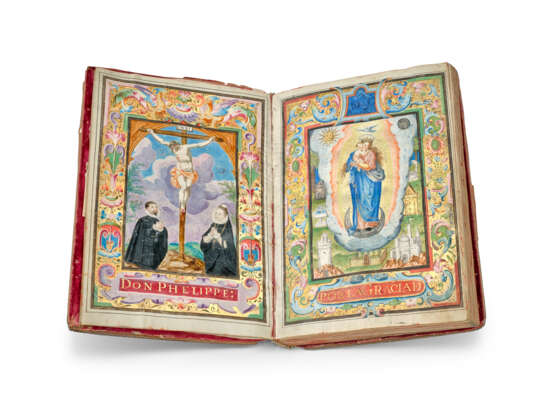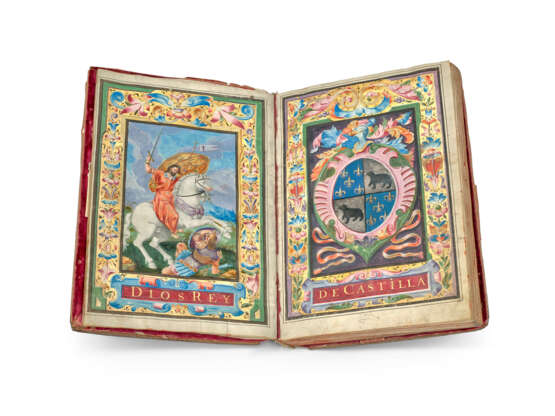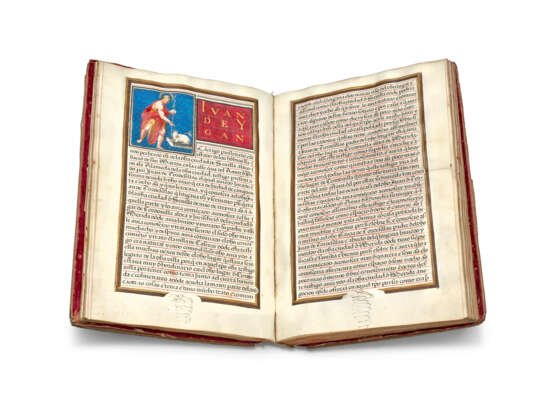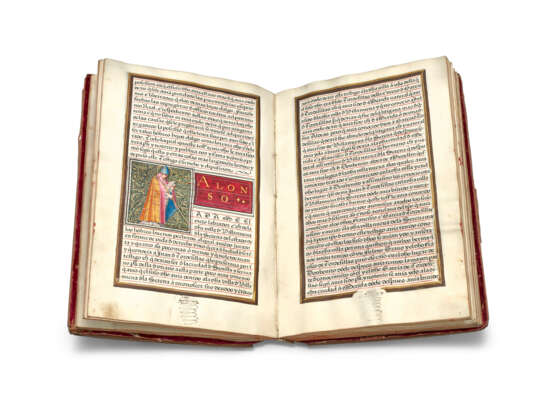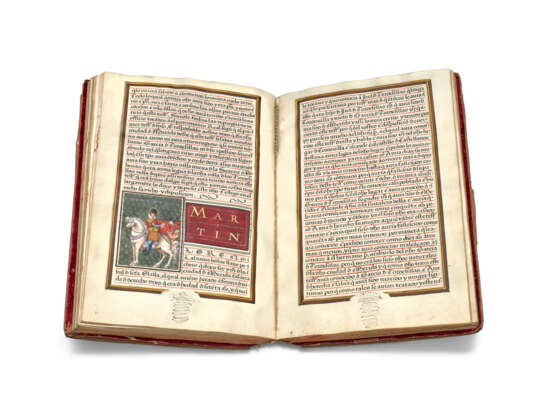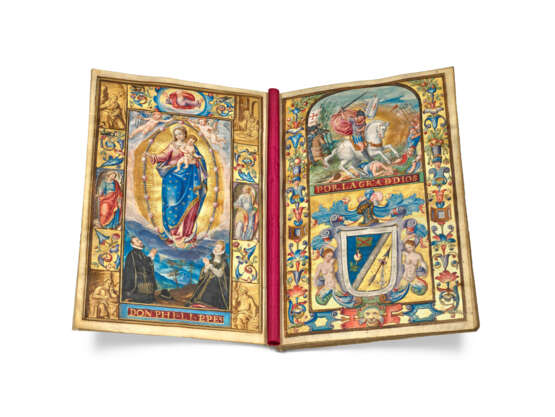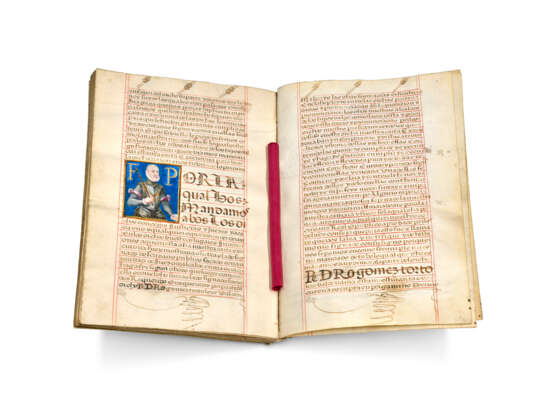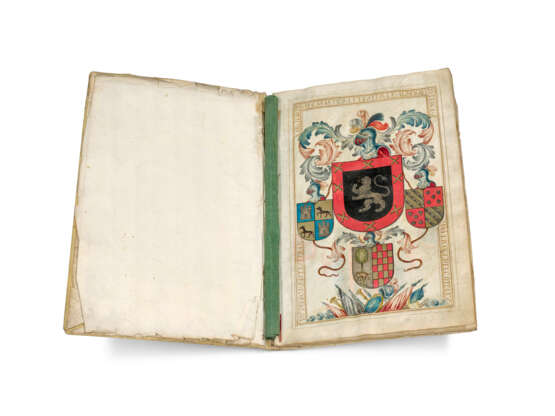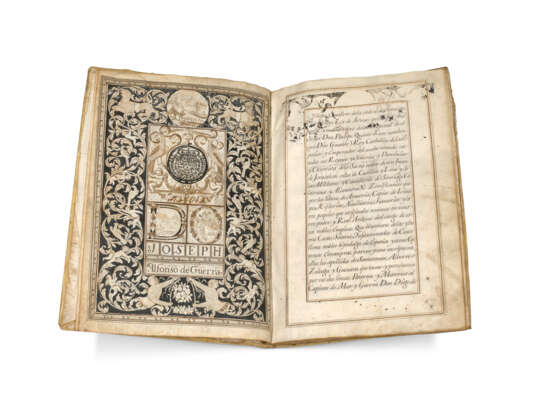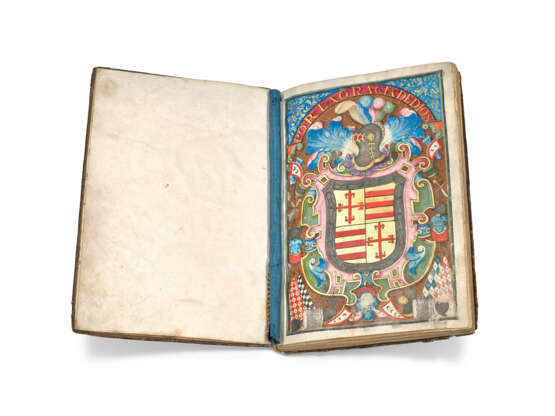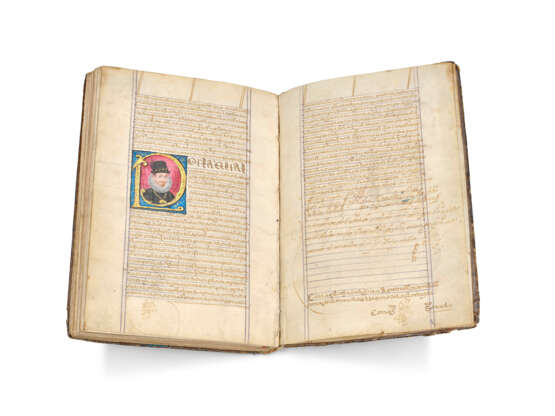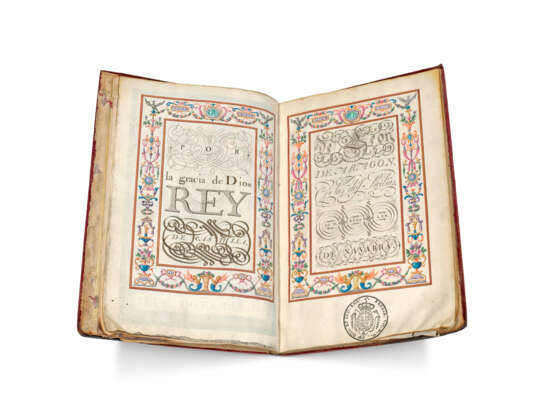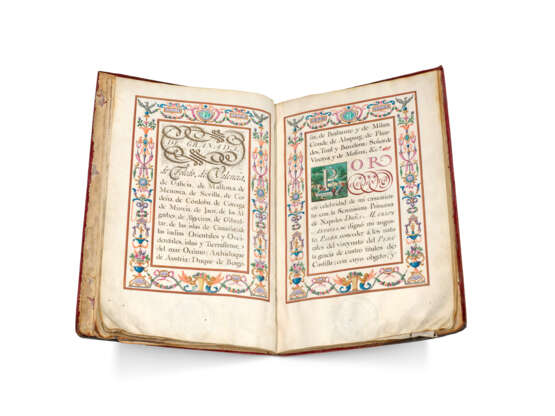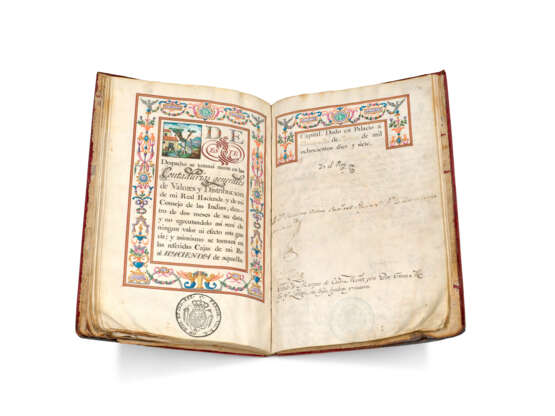ID 1349681
Los 27 | A collection of 5 Spanish grants of nobility and arms
Schätzwert
£ 8 000 – 10 000
Cartas executorias, in Spanish, illuminated manuscripts on vellum [Spain, 16th to 19th centuries]
A splendid group of Spanish grants of nobility and arms, dating from the 16th to the 19th centuries, all richly illuminated; one issued for a 19th-century mayor of Lima, Peru.
(a) Carta Executoria de Hidalguia of Juan de Tordesillas, resident of Seville, issued by Philip II of Spain, in Spanish, illuminated manuscript on vellum, Seville, 19 January 1595.
300 x 206mm. 86 leaves, the final three leaves ruled blanks, complete, contemporary foliation followed here, 32 lines of text framed in liquid gold and brown, ruled space: 240 x 148mm, panels in red with the names of the sponsors in liquid gold, 4 full-page illuminations: one of Juan de Tordesillas and wife kneeling before the Crucifixion (f.1v), one of the Virgin and Child in a mandorla with cityscapes below them (f.2), one of St James Matamoros (f.2v), and one with the coat of arms of Juan de Tordesillas (f.3), 23 panel miniatures depicting Saints, virtues and Philip II (some marginal soiling). Bound in contemporary red velvet over wooden boards (tattered and worn, with losses especially at the spine, upper board almost detached, lacking clasps).
[With]:
(b) Carta Executoria de Hidalguia of Pedro Gomez Tortolero Valderrama, resident of Écija, issued by Philip II of Spain, in Spanish, illuminated manuscript on vellum, 4 March 1589.
310 x 211mm. 54 leaves, the final two leaves ruled blank, complete, 34 lines of text, ruled space: 245 x 132mm, 13 large initials in liquid gold on red or blue grounds with silver infilling, one miniature depicting Philip II, 2 full-page illustrations: one depicting the Pedro Gomez and wife kneeling before the Virgin and child (f.2v), the second with St James Matamoros above and the coat of arms of Pedro Gomez below, both within a full border of liquid gold with Renaissance motifs, Saints and prophets (some marginal staining and thumbing). Lacking binding.
(c) Carta Executoria de Hidalguia of the brothers Pedro and Francisco Trujillo, residents of Vejer de la Frontera, issued by Philip III of Spain, in Spanish, illuminated manuscript on vellum, Granada, 28 July 1607.
310 x 211mm. i + 68 leaves, complete, 34 lines of text, ruled space: 240 x 130mm, 14 large initials in liquid gold on red grounds with silver infilling, one large full-page armorial frontispiece, one panel miniature depicting Philip III (blue silk curtain protecting the armorial frontispiece threadbare and worn, some rubbing and marginal thumbing, a few smudges). Bound in contemporary Spanish calf over wooden boards tooled in gilt (rubbed, edges scuffed, spine cracked with some small losses).
(d) Grant of Arms, issued by Don Joseph Alfonso de Guerra, 'Chronista y Rey de Armas' to Philip V of Spain, in Spanish, illuminated autograph manuscript on vellum, Madrid, 7 January 1715.
305 x 210mm. 18 + ii, plus two documents tipped in at the end, complete, 23 lines of text written by Joseph Alfonso de Guerra (1646-1722), notarised with his signature at end, written space: 220 x 110mm, the text within a double frame in liquid gold and black, two green silk curtains interleaving the illustrations, one full-page armorial frontispiece with the arms of Santesteban, Alberro, Zuluaga and Guebara, one full-page portrait of Philip V on horseback with the caption 'PHILIPPUS V / DEI GRATIA / HISPANIARUM REX', f.1v with the arms of Jose Rodriguez de los Rios y Lorada added in 1893 (a little soiled and warped). Bound in contemporary vellum over pasteboards (a little warped and yellowed). Provenance: (1) Don Diego de Santesteban Zuluaga of Hondarribia (Fuenterrabia) in the province of Gipuzkoa: grant of arms and descriptions of the maternal and paternal lineages, dated 7 January 1715. (2) The manuscript evidently remains in the same family: a 1719 document signed by the Bishop of Cadiz is tipped in at the very end, along with a letter addressed to Francisco Guiral and Maria Santesteban Zuluaga from Pope Clement XI dated 7 July 2019. Subsequently: (3) Jose Rodriguez de los Rios y Lorada, who married Maria de los Dolores de Santesteban y Chamorro: he adds his arms to f.1v in 1893.
(e) Carta Executoria de Hidalguia of Tomás Muñoz y Lobatón, resident of Lima, Peru, issued by Fernando VII of Spain, in Spanish, illuminated manuscript on vellum, Madrid, 22 February 1817.
300 x 200mm. v (paper) + 10 + v (paper) leaves, complete, 17 lines of text, written space: 175 x 105mm, each page within a full illuminated border, each page notarised with the royal armorial stamp of Fernando VII, one full-page emblematic illustration with the armorial stamp of Fernando VII, two calligraphic title-pages within full borders, 5 miniatures of villages and pastoral scenes, calligraphic titles throughout, signed 'Yo el Rey' at end (the flyleaves and silk pastedown severely wormholed, a few sporadic wormholes throughout, but the text generally intact). Bound in contemporary red velvet over wooden boards (scuffed and worn, lacking clasps, corner- and center-pieces). Provenance: Tomás Muñoz y Lobatón (born in Lima, Peru, in 1758), Knight of the Order of Alcántara and mayor of Lima: the present manuscript grants him and his heirs the title of Marquis Casa Muñoz. When he died, the title passed to his only daughter Josefa Muñoz Bravo de Castilla, 2nd Marchioness of Casa Muñoz.
| Herkunftsort: | Europa, Spanien |
|---|---|
| Kategorie des Auktionshauses: | Handschriften des Mittelalters und der Renaissance, Bücher und Handschriften |
| Herkunftsort: | Europa, Spanien |
|---|---|
| Kategorie des Auktionshauses: | Handschriften des Mittelalters und der Renaissance, Bücher und Handschriften |
| Adresse der Versteigerung |
CHRISTIE'S 8 King Street, St. James's SW1Y 6QT London Vereinigtes Königreich | |
|---|---|---|
| Vorschau |
| |
| Telefon | +44 (0)20 7839 9060 | |
| Aufgeld | see on Website | |
| Nutzungsbedingungen | Nutzungsbedingungen |
